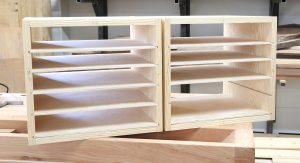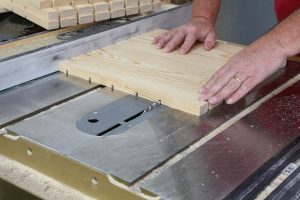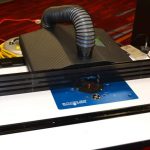We may receive a commission when you use our affiliate links. However, this does not impact our recommendations.
 I’ve had a bit of time in the shop this week, so I went back to work on the storage boxes that sit inside my yet-to-be-built workbench. I know. It’s been almost six months and I’m still just building the boxes – managing editor duties are many.
I’ve had a bit of time in the shop this week, so I went back to work on the storage boxes that sit inside my yet-to-be-built workbench. I know. It’s been almost six months and I’m still just building the boxes – managing editor duties are many.
After knocking out my dovetails, I laid out and cut the grooves for the sliding drawers I discussed in an earlier (much earlier) blog. (If you need to catch up, or to simply remember my plan, read this.) I used an Infinity Tools Thick-kerf, Flat-top table saw blade (1/4″ width) to make the grooves, registering the bottom edge of each drawer box side toward the fence with each pass of the four sides.  I then used a router table to rabbet the rear edges for my backboards.
I then used a router table to rabbet the rear edges for my backboards.
I applied glue to the dovetails and assembled the two boxes. As the glue dried I turned my attention to the plywood drawer bottoms. Before I had picked up a piece of Baltic birch plywood (BBP) from a local supplier, I checked my local home-center store for a usable plywood. I found 1/4″-thick plywood with one face sanded and sheets marked for underlay, but no BBP. I wanted BBP.
If you’re not aware of the differences between Baltic birch plywood and other “regular” plywood, the left-hand photo shows everything you need to know. (Click the photo to see it larger.)  BBP, in the 1/4″ or 6mm thickness, is made up of five layers of birch veneer that is 1.3mm to 1.5mm in thickness. Also, there are no voids in the layers that could cause defects or lessen its structural integrity. Compare the BBP edge (Bottom) to that of the regular plywood (Top). The top piece has three layers with the center layer turned 90° to the faces. The extra two layers in the BBP increase stability (less warp), provide an edge that reacts more like hardwood, and it’s my opinion that Baltic birch plywood is a more consistent thickness across the piece. That makes this plywood a better choice for furniture, jigs and shop-grade cabinets.
BBP, in the 1/4″ or 6mm thickness, is made up of five layers of birch veneer that is 1.3mm to 1.5mm in thickness. Also, there are no voids in the layers that could cause defects or lessen its structural integrity. Compare the BBP edge (Bottom) to that of the regular plywood (Top). The top piece has three layers with the center layer turned 90° to the faces. The extra two layers in the BBP increase stability (less warp), provide an edge that reacts more like hardwood, and it’s my opinion that Baltic birch plywood is a more consistent thickness across the piece. That makes this plywood a better choice for furniture, jigs and shop-grade cabinets.
At one time, Baltic birch plywood was available in only a 5′ x 5′ sheet. Today you can get other sizes such as 4′ x 8′ or even 5′ x 10′.
If you need plywood with a mahogany, walnut or birch face veneer, go to regular plywood. But if you are looking to veneer your own panels, or you need a stable plywood for jigs and other shop-made doodads, I suggest an nice sheet of BBP.
Read more about plywood in, “Choose the Right Plywood” by Robert W. Lang, or discover how to turn plywood into a couple of new jigs to make work at your table saw even better in the DVD “Table Saw Jigs & Fixtures.”
Here are some supplies and tools we find essential in our everyday work around the shop. We may receive a commission from sales referred by our links; however, we have carefully selected these products for their usefulness and quality.









Watch out for that “good” looking Birch and Oak plywood in the home stores. I bought some to use for a few scroll saw puzzles. It was beautiful on the outside and had 5 layers but inside there were more voids than I care to mention. I had to throw away more than one puzzle because the voids were so large and went from one side of the puzzle to the other that they could not reasonably be filled with wood puddy. The ply wasn’t all that cheap either. I now order my scroll saw ply from Heritage, never a bad piece.
After a project, I ended up with a sheet of 3/8″ BC ply left, and it sat on two horses under a carport for a week. Myself, and a friend, watched it do all kinds of contortions with the humidity outside; it really moves around.
Glenn, that new photo of you looks like you lost some weight . Elmer
Glen
In that comparison pic, what did you cut the BBP with, a chainsaw? Lookit those raggedy edges. Sorry devil made me do it. 🙂
I completely agree with you. I feel like in recent years it’s been harder to find BBP, but worth the extra hunting around.
I’ve had several full size sheets of 3/4″ shop grade (but good quality from a reputable American manufacturer) maple veneered plywood warp a bit just sitting in the corner of the shop (which is temp and humidity controlled). Ironically they were leaning on some BBP that has not moved at all.
Ah, yes. I made quite a few pieces in my “early” period with the cheapest “plywood” I could find. It was interesting to say the least.
For BBP less than 3/4″ thick and in smaller sizes, (i think the largest they’ve got is 2 feet by 1) I’ve found the local craft store has them in the model making section. It’s not the highest quality stuff, and the price isn’t great, but they’re nearby and open late – when I want to nail a shelf bottom on something I’m making for the shop at 9:30pm on a Friday, I know where to go!